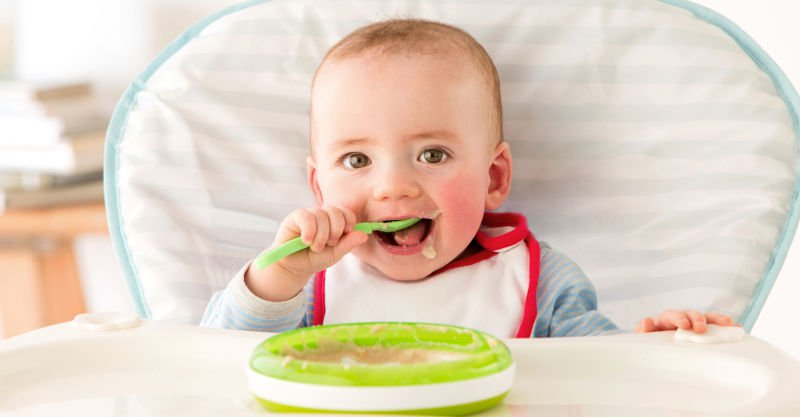A parent’s guide to the nutrition essentials for little eaters

Introducing solid food to your baby is exciting but with so many food options, it can feel a little overwhelming too. With a whole buffet of possible foods to offer, where do you start?
The best place to begin is by focussing on foods that are nutrient-rich and will give your baby all the things she needs to grow healthy and strong.
Start slow
From about six months, babies need solid food in addition to their milk feeds to get the nutrients they need for healthy development. Aim to offer one ‘meal’ a day in the first weeks, and always after a milk feed – breast milk or formula should continue to be the main milk drink for babies up to 12 months. In fact, from 6 to 12 months, breast milk or formula should provide 50 percent of your baby’s energy needs, so solid food should not replace milk until after your baby’s first birthday.
Introduce one food at a time over several days, so you can keep an eye out for any possible sensitivities or allergies. Introducing your baby to one food at a time also allows her to identify and become familiar with individual tastes and textures, which will help you later on when you begin combining ingredients.
There is no need to add any salt or other flavours to your baby’s food – the natural flavour is more than enough of an experience for your baby’s little tastebuds.
Mind the bumps
Start with smooth purees for baby in the early days to avoid gagging – your baby will struggle with more lumpy textured foods initially. As your baby becomes confident swallowing smoothing purees, you can graduate to slightly thicker mixes, and then onto more soft lumpy purees, and so on … Your baby will be able to handle more highly textured foods as she becomes a more experienced eater and more developmentally able.
And don’t let the fact that she doesn’t have many (or any!) teeth confuse you – those gums are tough and can chew their way through a wide range of textured foods!
A note on the gagging reflex
Gagging is a normal reflex – and a reflex that is very strong in young babies. The gag reflex is triggered whenever the back of the throat is stimulated and causes the tongue to push forward. This reflex can make the early days of introducing solid food challenging because it can mean that just as much food comes back out of the mouth as you are putting in! Be patient and gently persist because this reflex will relax as your baby learns to control the amount of food she is swallowing.
In short, don’t be alarmed if your baby gags when you are feeding her – just let her take a breath and when she is happy to continue, gently offer her another spoonful of food.
Iron
Babies are born with iron reserves but these diminish over the first six months of life – particularly if your baby is breastfed – and so it’s important for first foods to include something that is iron-rich.
Iron-fortified rice cereal is often the very first food that babies in Australia are introduced to. Rice cereal is mixed with breastmilk, formula or water and can initially be thinned so that it’s almost a milk-like consistency. It is an excellent first food because commercially made products are iron-fortified, providing a much-needed supply of this trace element that is so important for healthy development.
Beyond rice cereal, other excellent sources of iron that are baby-friendly are:
- Egg yolks
- Chicken and turkey
- Red meat – beef, lamb or pork
- Spinach
- Broccoli
- Brussels sprouts
- Green peas
- Beans
- Fortified breakfast cereals
It’s a great idea to serve iron-rich foods with a food that is rich in vitamin C like berries, tomatoes, mango or red capsicum to aid iron absorption.
Protein
Protein is important for your baby’s growth and muscle development. Easy baby-friendly sources of protein include:
- Red meat
- Fish
- Chicken
- Eggs
- Beans
- Lentils
Nuts are also a good source of protein but are often avoided because of their allergy risks. However, the ASCIA (Australian Society of Clinical Immunology and Allergy) recommends that common allergy foods, including nuts, should be introduced to babies before 12 months, as delayed introduction has been shown to increase the chance of developing a food allergy.
These foods also contain other useful vitamins and minerals like iron, zinc, vitamin B12 and omega-3 fatty acids.
Zinc
Zinc is a mineral that is vital to support the healthy growth of children, particularly the reproductive organs and the brain. It plays a role in maintaining a strong immune system. Zinc deficiency has been linked to loss of appetite, decreased growth, as well as increased colds and infections.
Good sources of zinc can be found in:
- Red meat
- Wholegrain bread and cereals
- Dried beans
- Nuts (see note above about introducing nuts to infants)
Zinc can also be found in small amounts in breast milk.
Calcium
Calcium is an essential nutrient for bone health – and is vitally important for growing children. Dairy foods are the best sources of calcium and include:
- Cow’s milk
- Yoghurt
- Cheese
Additionally, there are calcium-fortified foods available if you are concerned your baby is not getting enough dairy in her diet.
Until 12 months, your baby’s milk diet should only be breastmilk or formula. After 12 months, full-fat cow’s milk can be introduced. Until the age of two, children should drink full-fat milk to meet their energy needs.












